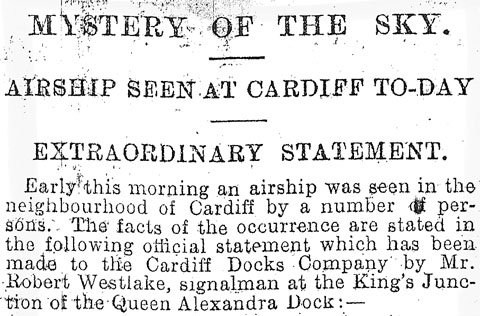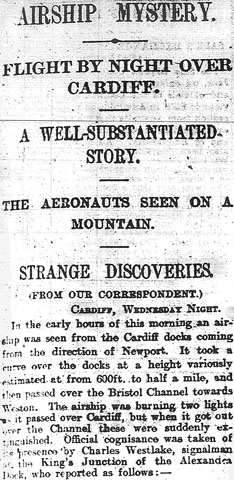
After yesterday’s excitement, today is something of an anticlimax as far as scareships are concerned. In fact, it’s more like a backlash.
There are some new sighting reports, from Wales again and from Birmingham. The Manchester Guardian reports (p. 7) that Oliver L. Jones, a Monmouth auctioneer (of Messrs. Nelmes, Poole, Jackson and Jones), his wife and two passengers were driving from Tregarog late on Sunday night when they saw an airship.
“I can believe my own eyes and ears. It was about eight miles from Monmouth when I first saw it. It came from the direction of Raglan, and seemed to go towards Chepstow. It then turned right round and came back towards Raglan and over the mountain. I continued to drive slowly on, and watched it for about half an hour. I was driving eight or ten miles an hour, but the airship seemed to go faster than that. I could see the cigar shape quite distinctly, and noticed the perfect control the occupants had over the airship.”
The other report is sketchy: it seems that ‘for several nights people living in Small Heath, a suburb of Birmingham, have seen what is stated to be an airship passing over the district’. Interestingly, it is described as cigar-shaped although no lights were seen. Local opinion is that it belongs to ‘a local inventor […] making trial trips’.
The main story today, however, is that a solution to the mystery may have been found by the Daily Express (or perhaps the Pall Mall Gazette. Both the Manchester Guardian and the Standard carry this story today. The latter has the fullest story (p. 21). Percival Spencer, ‘the well-known aeronaut’, thinks that he is (indirectly) responsible:
the perfect cloud of small airships which has been infesting the heavens for the past ten days can only be accounted for by the supposition that some enterprising firm in search of a colossal advertisement has been purchasing large quantities of his Spencer’s model airships.
These unmanned airships are about 25 feet long, and sustained by hot air generated by a spirit lamp. This lamp could account for the lights which the witnesses have described (well, one of them, at least). The Standard also points out that it’s ‘impossible’ to estimate the true height of an airship at night, so a small airship at low altitude could look like a much bigger airship much higher up. Spencer says he has sold ‘great numbers’ of this model recently. What’s more, he has also sold five larger ‘man-lifting’ airships in the last year. He knows one went to ‘a firm of manufacturers whose headquarters are in the Eastern Counties’ and another was sold to a man living in — wait for it — Cardiff! The other three he could probably trace with a bit of research. This does indeed sound like a potential solution to the sightings. But one has to wonder what sort of advertising campaign leaves people in the dark as to what they should be be buying …
The Manchester Guardian focuses more on the French-labelled plug found on Caerphilly Mountain, where the showman had his close encounter. It turns out (p. 7) that it is a label which the Michelin Company puts on a pin attached to the inner tube of its motor-car tires. So it’s nothing suspicious at all, and is just the sort of thing you might expect to find by the roadside, even this early in the motor age.
The same paper’s London correspondent (p. 6) repeats this explanation (noting that the Star also carried it), and takes the London dailes to task for jumping to the conclusion that the French word ‘obus’, which appeared on the label, should be interpreted as ‘shell’ (in the military sense) instead of valve plug, which is the engineering meaning. There then follows a rather forced parody of the plug affair (though I do like the reference to the ‘technical scareship press’), with a submarine replacing the airship, a metal lid with German writing instead of a plug with French writing, with the punchline being the discovery of a postcard with the word ‘Schlangenbad’ which is interpreted to mean ‘sea-serpent’:
My correspondent thinks that explains everything, especially as the weather is getting rather hot.
The sea serpent here is a reference to the coming of the summer silly season, when there’s little real news and so editors are forced to run ridiculous stories which wouldn’t normally get a look-in. Is this another potential explanation for the phantom airship scare?
Everyone’s suddenly making fun of the scareships. The only mention of them in today’s Globe is in the humor column (well, I think that’s what it is) on the front page:
No airship scare has yet come from Peebles.
Well, it’s over my head! The Manchester Guardian has the following poem by C. MacT., entitled ‘On the mysterious airship’:
Folks are lately much afeared
Of a Something that appeared
In the skies at dead of night,
With its eyes so baleful bright.
Is it what our German cousiins
Have been turning out by dozens?
Is it our or is it their ship,
This noctivolanting airship?
Does this victor of the air
Speak us foul, or speak us fair?
Is she Angel, is she Ogress?
Is it Peace as well as Progress?
Who can tell it!
We have come by rapid stages
To the “heirship of the ages” –
How d’ye spell it?
Probably best if C. MacT.’s real name remains undiscovered.
Finally, a possible naval parallel to the airships. As noted above, the Manchester Guardian had some fun with the idea of a German submarine lurking off the coast. But a few weeks back — so it has been claimed, though the First Lord of the Admiralty, Reginald McKenna, denied all knowledge of it — two German merchant vessels were commandeered in Hamburg by the German army, filled with soldiers, and sailed to the mouth of the Humber, and then back again. The inference is that this was a trial run for an invasion (not unlike that at the climax of The Riddle of the Sands, perhaps). The naval correspondent of the Globe has a followup story on this (p. 5) today, tying it to a mysterious affair last week where a seaman serving on the battleship HMS Majestic was arrested and then discharged from the Navy. It seems — the source is not given — that the seaman’s brother serves upon one of the German ships, and had sent him an letter describing the invasion trial, which was (more or less) the reason for the arrest. The article concludes with a sting in the tail:
One point, however, now clearly established is that the Humber experiment did actually take place without the fact being brought to the notice of the Admiralty until some time afterwards. How long will it now take the Admiralty to learn, officially, that within the past week or so British warships have come across a German trawler in the North Sea fitted with wireless telegraphy?
Well might one ask.
![]() This work is licensed under a Creative Commons Attribution-NonCommercial-NoDerivatives 4.0 International License.
Permissions beyond the scope of this license may be available at http://airminded.org/copyright/.
This work is licensed under a Creative Commons Attribution-NonCommercial-NoDerivatives 4.0 International License.
Permissions beyond the scope of this license may be available at http://airminded.org/copyright/.





“Man-lifting” model airship? And I thought the Pou en Ciels were nuts.
I am utterly fascinated by these accounts you are republishing. Not so much for the mystery as the revelation to me that ballooning (airshipping?) was in such an advanced state at that time.
In today’s entry I was fascinated by the comments of Percival Spencer “well known aeronaut” who seemed to have had quite a developed industry in manufacturing small airships.
I did a little googling and found http://www.ballooninghistory.com which contains a brief bio of him. As terse and telegraphic as the entry is it seems that our aeronaut had quite a career.
There seems to have been a wealth of airship knowledge widely available during these years. I can just about buy the possibility that indeed some secretive airship designers were experimenting under the cover of darkness to perfect their crafts.
Pingback: Airminded · Saturday, 22 May 1909
Pingback: Airminded · Monday, 24 May 1909
Erik:
I might have elided the different sense of ‘model’ there. The man-carrying airships could carry two men, they weren’t actual ‘models’ in the sense of toys. There’s a 1909 example here — actually a one man, one woman model!
Rick:
Thanks for that link! It seems the Spencers were quite an airmad family, I had no idea.
Pingback: Airminded · Post-blogging the 1909 scareships: thoughts and conclusions
Pingback: What the showman saw | Airminded